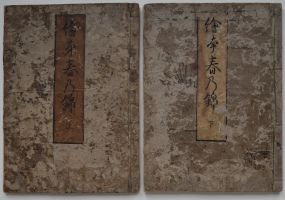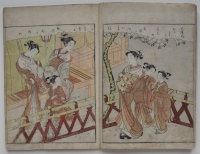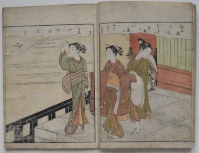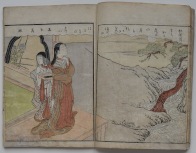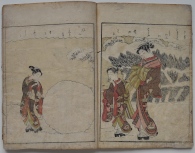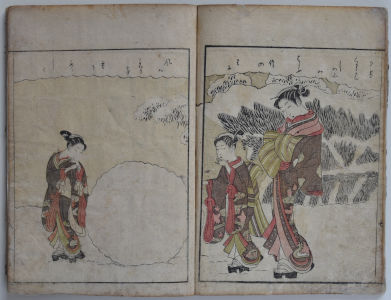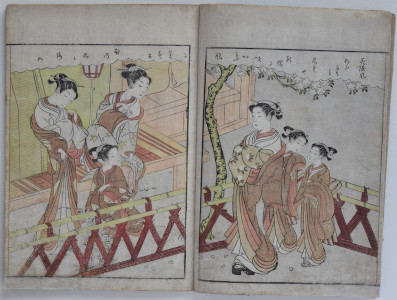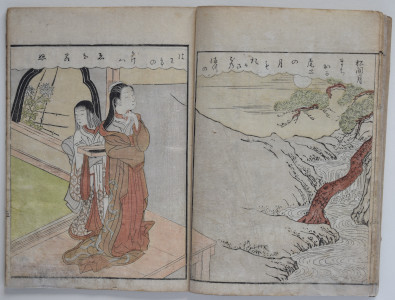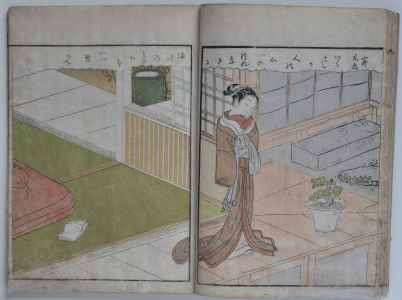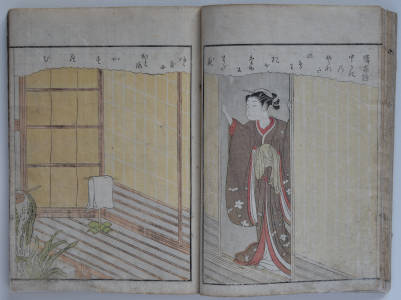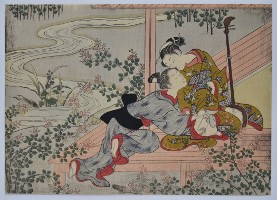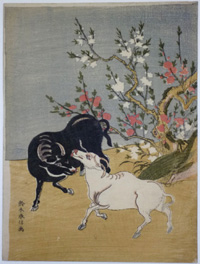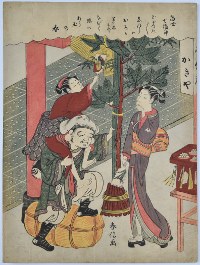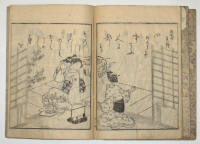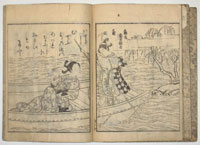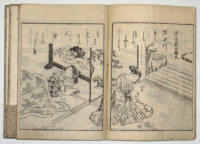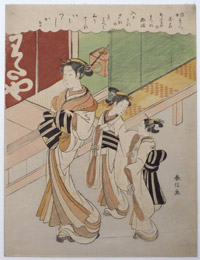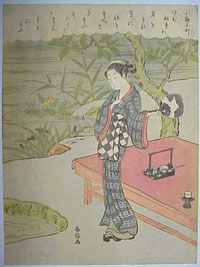Suzuki HARUNOBU (1724-1770)
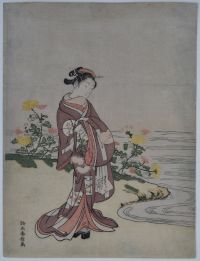
Click here to view image full size.
A beauty standing beside a stream where wild chrysanthemums grow. A mitate-e (parody) of Kikujido, the Chrysanthemum Boy, who was the favourite of the Chinese Emperor Mu (c. 950 B.C.). However, because of court jealousy, he was banished but had his exile eased by the Emperor who gifted him the ability to read sacred Buddhist texts. He became an immortal, spending his days surrounded by chrysanthemums and inscribing words of peace on the flowers’ petals. This is the second state: The first (private edition) is a calendar print with a signature (of an amateur) Kinga Ko and seal and has the year and its cyclical signs for 1766. These Harunobu calendar prints, printed in small numbers, were commissioned by wealthy individuals between c. 1764 and 1766 and so popular that they were published commercially. Rare.
Very good impression and colour Very minor edge soil, otherwise very good condition. Signed Suzuki Harunobu ga.
Status: Available
Suzuki HARUNOBU (1724-1770)
Click here to view image full size.
Two volumes complete: Ehon haru no nishiki, “Picture Book: The Brocades of Spring.” Vol. 1: 1 page preface dated Kanoto U (1770); single page and 8 double page colour prints. Vol. 2: 1 single page and 8 double page colour prints. 1 page colophon with date, publisher, block-cutter and artist as Suzuki Harunobu with his seal. 2 pages publisher’s announcements. Published by Yamazaki Kimbe, Edo. This is the first edition, Meiwa 8 (1771). Other copies are in the MFA, Boston, acc. no. 1997.477.1-2 and the Philadelphia Museum of Art, acc. no. 1970-46-1. Provenance: Ex collections H.M.Kaempfer and Hayashi (their seals on the first page of each volume). Original covers and title slips. Covers worn. Some soil and edge restoration.
Very good impressions with generally very good colour. Rare in the first edition.
Status: Available
Suzuki HARUNOBU (1724-1770)

Click here to view image full size.
A pillar print showing a young dandy holding an Odawara lantern on entering a Shinto shrine. One leg of the Torii is in the background behind a hinoki tree. Another impression is illustrated in The Japanese Pillar Print, Hashira-e, Jacob Pins, Robert G. Sawers publishing, 1982, 184a, p. 118 which also shows a variant impression with a night sky, 184b.
Very good impression. Good colour for a pillar print: This format is notorious for fading and browning. Very good condition. Signed Suzuki Harunobu ga.
Status: Sold
Suzuki HARUNOBU (c 1725-1770)
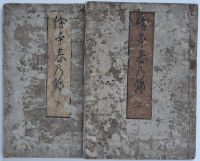
Click here to view image full size.
Two volumes complete: Ehon haru no nishiki, “Picture Book: The Brocades of Spring.” Vol. 1: 1 page preface dated Kanoto U (1770); single page and 8 double page colour prints. Vol. 2: 1 single page and 8 double page colour prints. 1 page colophon with date, publisher, block-cutter and artist as Suzuki Harunobu with his seal. 2 pages publisher’s announcements. Published by Yamazaki Kimbe, Edo. This is the first edition, Meiwa 8 (1771). Other copies are in the MFA, Boston, acc. no 1997.477.1-2 and Philadelphia Museum of Art, acc. no. 1970-46-1. Provenance: Ex collections H.M.Kaempfer and Hayashi (their seals on the first page of each volume). Original covers and title slips. Covers worn. Some soil and edge restoration. Very good impressions with generally very good colour. Rare in the first edition.
Status: Sold
Suzuki HARUNOBU (1724-1770)
Click here to view image full size.
A wonderful chuban shunga print showing a young suitor leaning across an engawa and interrupting a beauty playing a shamisen by partially lifting her robe. They are surrounded by flowering bushes and a meandering stream. A rare design I cannot, at the moment, locate being illustrated. Published c. late 1760s.
Very fine impression on thick hosho. Extremely fine colour. Slight oxidation, otherwise fine condition.
Status: Sold
Suzuki HARUNOBU (1724-1770)

Click here to view image full size.
A chuban shunga print showing the occupant of a kago in flagrante with one of the porters, having seized the opportunity of a stop on the journey. Published late 1760s. Rare.
Very fine impression on thick hosho: The outlines raised in certain areas. Fine colour and condition.
Status: Sold
Suzuki HARUNOBU (1724-1770)

Click here to view image full size.
A couple in flagrante on an open engawa which has a large bowl of goldfish. There were many attempts by the Tokugawa Shogunate (1603-1868) to suppress shunga with edicts issued in 1661, 1722 and the 1790s. None of these were particularly effective and production usually resumed with most Ukiyo-e artists producing shunga prints, books or paintings. Published c. 1768. Unsigned as often with these shunga prints.
Superb impression. Fine, unfaded colour. Fine condition.
Status: Sold
Suzuki HARUNOBU (1724-1770)

Click here to view image full size.
A chuban shunga print showing a fisherman taking advantage of a young girl on a boat on the Sumida River. The couple are hidden behind a four-armed scoop-net called a yotsude-ami which was used to catch whitebait in the spring. The British Museum copy (OA+,O.125) gives the location as most probably being at Mitsumata, between Eitai and Shin’o bridges, based on what looks like Lord Tayasu’s residence in the background. Another impression is illustrated in Shunga, Marco Fagioli, Octavo, 1997, no. 23, p.45. Published late 1760s. Rare.
Very good impression. Some slight fading, otherwise good condition.
Status: Sold
Suzuki HARUNOBU (c 1725–1770)
Click here to view image full size.
A chuban print of a pair of oxen. One of the Junishi, Twelve Zodiacal Signs ( this being Ushi ). Complemented here by a red and white plum tree. People born in the Year of the Ox are known to be difficult but, once committed, they are loyal for life. And the plum tree symbolizes conjugal loyalty. Exceptionally rare: One other impression is illustrated in Yoshida, Harunobu zenshu, p. 112. Indeed, Harunobu designed very few kachoga, unlike Koryusai who made many a few years later. This could have been intended as one of a set of twelve prints, but the likelihood is that it is a single design. Published c 1767.
Fine impression with the outlines of the oxen heavily gauffraged. Exceptional condition: The background blue is from the dayflower ( Commelina communis L. ). One of the most fugitive pigments, here completely intact. The petals were collected at dawn, squeezed, and applied to paper which was used as a carrier. Very fine colour and condition. Signed Suzuki Harunobu ga.
Status: Sold
Suzuki HARUNOBU (1724-1770)
Click here to view image full size.
A fine chuban from a series parodying the Seven Gods of Good Fortune, this being Daikoku, the god of wealth, seen here attempting to stand on one of his straw bales of rice. The famous waitress Kasamori O-sen (1751-1827) stands holding a battledore on New Year’s Day while her companion balances on Daikoku’s shoulders attempting to retrieve the shuttlecock caught in the kado-matsu decorations using her own battledore. The lantern on the right reads Kagi-ya, which was a tea-house located by the Kasamori Inari Shrine in Yanaka, north of Edo, which was owned by O-sen’s father and where she was the waitress. Considered to be one of “The Three Beauties” of her time. (Given the date of the print, she must have been around 18 when shown here.) The Torii gate is seen on the left. The poem above speaks of a New Year’s fresh gem [O-Sen] and how the trees and grasses bend to her. Published c. 1769.
Fine impression: As with many Harunobu, the lines are in relief because of the thick hosho. Exceptional colour: Even the vegetable blue used for the paving stones leading to the temple have not turned except at the extreme left and right. This was a colour used frequently by Harunobu to depict water but is almost always faded to a puce colour. Minimal soil, otherwise a fine example from this period. Signed Harunobu ga.
Status: Sold
Suzuki HARUNOBU (1724-1770)
Click here to view image full size.
3 volume complete : Ehon yachiyogusa, “The Plant of Eight Thousand Ages”. Sumi images illustrating old poems with the Sumida River as a central theme. Published Meiwa 5, 1768 by Yamazaki Kinbei.
Original covers but later title slips. One page with sumi marks, otherwise good impressions and condition.
Status: Sold
Suzuki HARUNOBU (1725-1770)
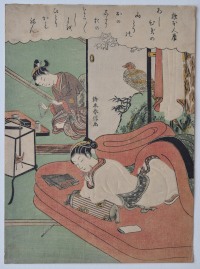
Click here to view image full size.
A chuban print from an untitled series showing a courtesan lying under a futon waiting for her kamuro to prepare her pipe in the adjoining room. A fusuma partially separates the two rooms and has a painting of a mountain pheasant on a craggy rock (alluded to in the poem above which is by Kakinomoto no Hitomaro, one of the famous Thirty-six Immortal Poets). This poem, which is also interpreted by Hokusai in his set One Hundred Poems Explained by the Nurse, is complex and speaks of long nights dragging by like a mountain trail or a pheasant’s tail. Published c 1768. A particularly rare Harunobu: Another impression is in the BM: A_1937-0710-0-18.
Fine impression with beautiful blind-printing delineating her body. The material hanging behind her is also gauffraged. Very good colour. Minor soil and signs of mounting au verso, otherwise very good condition. Signed on the fusuma Suzuki Harunobu ga.
Status: Sold
Suzuki HARUNOBU (1724-1770)
Click here to view image full size.
A chuban showing the courtesan Matsukaze of the Ogi-ya House from a set of prints: Ukiyo kika, “Strange Flowers of the Floating World.” Shows the courtesan parading outside a Yoshiwara house with her two kamuro. One of the most influential ukiyo-e artists taking full advantage of polychrome printing in 1765 and publishing a large number of exquisite prints, often with innovative pigments and on thick hosho. Published c late 1760s. Another impression in Yoshida, Harunobu zenshu, p. 128.
Fine impression. Slight fading otherwise very good condition. Signed Harunobu ga.
Status: Sold
Suzuki HARUNOBU (1724-1770)
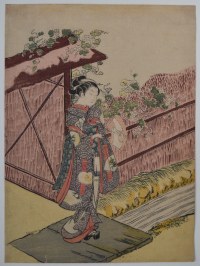
Click here to view image full size.
The left sheet of a rare diptych which was originally produced as an egoyomi (picture calendar) in 1766. A mitate (parody) of Chapter 4, Yugao, from the Genji Monogatari, “Tale of Genji.” This chapter relates how a mysterious beauty living in a mansion covered in vines with flowering yugao blossom (shown here covering the fence) enraptures Genji and they consummate their passion in a remote villa. However, one of Genji’s former lovers discovers the tryst and takes the life of “Yugao.” The right sheet shows a fashionably dressed young wakashu and a boy holding a miniature ox cart cricket cage. Other impressions in: Margaret O. Gentles, The Clarence Buckingham Collection, volume II, AIC, 1965, p. 26, no. 44; Tokyo National Museum, acc. no. A-10569_1274 (diptych) (inv. No. 10-5006); David Waterhouse, The Harunobu Decade, Museum of Fine Arts, Boston, 2013, vol. 1, pp. 88-89, cat. No. 100, acc. nos. 54.348-9 (diptych) and 21.4969 (left sheet); and Ukiyo-e Shuka, vol. 8, 1980, listed p. 116, no. 114. Rare.
Fine impression with the woodgrain showing strongly in the background as though it were blind-printed. Very good colour and condition.
Status: Sold
Suzuki HARUNOBU (1724-1770)
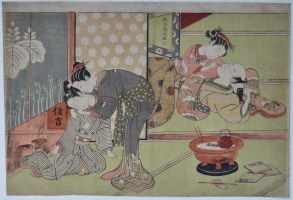
Click here to view image full size.
Two couples in a brothel. The young man near the entrance seems in need of a lot of encouragement. The name written on the left of the entrance is Sumiyoshi. A chuban yokoe design published c 1769-70. Another impression is in ROM, 926.18.121.
Very good impression and colour. Minimal soil, otherwise good condition. Signed Suzuki Harunobu ga on the rear screen.
Status: Sold
Suzuki HARUNOBU (1724-1778)
Click here to view image full size.
A chuban print of a young girl beside a stream. A poem above, by Ono no Komachi, compares her thoughts to a floating reed. One of a series based on “The Thirty-six Poets”. Another impression illustrated in the Philadelphia Musuem of Art catalogue Suzuki Harunobu, 1970, p.141, no.79. Published c.1767/8.
Superb impression with the girl’s outline and garment folds in heavy relief. Fine colour with only the water slightly down. Signed Harunobu ga.
Status: Sold
Suzuki HARUNOBU (1724-1770)
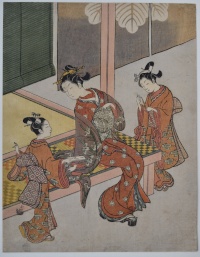
Click here to view image full size.
An unsigned chuban showing a seated courtesan with her two kamuro. One brings a letter while the other cleans her mistress’s tobacco pipe. Behind is a large kiri-mon on a noren. Published c. 1766-67. Other impressions in the Tokyo National Museum, Honolulu Academy of Arts and The Metropolitan Museum of Art. Rare.
Fine impression. Particularly well preserved colours: Most Harunobu prints sold are faded to some degree. Slight “turning” of the colour on the top of the noren and small smudge bottom left, otherwise very good condition.
Status: Available
Suzuki HARUNOBU (1724-1770)

Click here to view image full size.
A pillar print showing a beauty after a bath walking past a pot of morning glory. Published c. 1768. The morning glory is a precursor of hot summer. Some 40 or 50 years later there was a craze for these plants almost akin to Dutch tulip fever. Other (faded) impressions are in MFA, Boston, Spaulding Collection, nr. 21.4552; Honolulu Museum of Art, nr. 06108; and illustrated in Waterhouse, The Harunobu Decade, 20013, nr. 545. Harunobu produced some of the most sublime Ukiyo-e images and he and his publishers were at the forefront of experimentation in the 1760s using multiple blocks, new pigments and combing pigments to create new hues that were not see again in Ukiyo-e. Unfortunately, the pigments – most often of vegetable origin – were very susceptible to fading and most Harunobu prints are ghosts of their former selves. Harunobu was a master of this hashira-e format: Jacob Pins found 111 to illustrate in The Japanese Pillar Print, 1982. Rare.
Fine impression. Exceptionally good colour. Minor soil but in very good condition for a print in this format and of this period. (These prints were hung in alcoves or on pillars and they consequently often come browned or faded as well as getting creased by being rolled.) Signed Harunobu ga.
Status: Sold
Suzuki HARUNOBU (1725-1770)
Click here to view image full size.
A beautiful composition of a courtesan emerging from a mosquito net. Published c 1760’s. Ex collection Hayashi. Rare: not in Pins or Yoshida.
Very good impression and colour. Very slight soil but in very good condition for a pillar print of this period. Signed Harunobu ga..
Status: Sold
